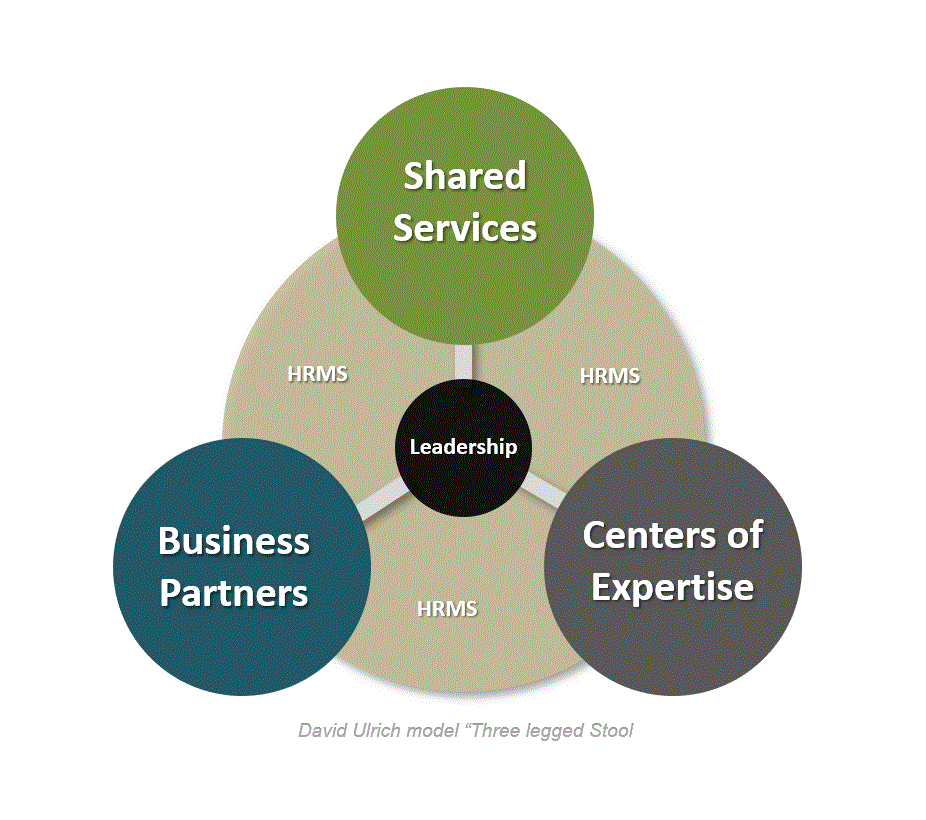Published by Tamer Elogueil
The three-legged stool model (Ulrich model), despite its widespread use, is limited to large, complex organisations. From the beginning, adaptation rather than straight adoption has been common for the model. Creating the three "legs" made internal communication more difficult and contact for customers potentially challenging. Adaptations have included centralised contact centres, mobile cloud services, and junior business partners to address these issues. The need for greater internal oversight or governance to ensure the policies and processes developed by experts are delivered effectively has been acknowledged by David Ulrich himself.
Despite these challenges, the Ulrich structure has proven resilient, likely due to its cost and service benefits. The fundamentals of the Ulrich model continue to offer a balance between effectiveness and efficiency, with necessary adaptations. Developed by David Ulrich in the 1990s, the model has significantly influenced modern Human Resources Management by dividing HR functions into three parts:
- Centres Of Expertise (CoE)
- Business Partners (BP)
- Shared Service Centres (SSC)

Centres of Expertise: Focus on designing programmes and policies. They clarify organisational capabilities and craft necessary HR investments and policies through centres of excellence or expertise that maintain critical fields of knowledge and a specialist core HR functional structure. These centres also drive innovation in HR practices and ensure continuous improvement by staying updated with the latest HR trends.
Business partners: Provide dedicated support as HR generalists, business stakeholders, and account managers aligned with business units. Business partners consult with business leaders on business and people issues, ensuring HR strategies are closely aligned with business objectives. They manage and resolve HR-related issues within their units, acting as a bridge between the strategic and operational aspects of HR.
Shared Service Centres: Handle day-to-day service delivery. They focus on administration and transactional personnel activities separately from the main HR group. These centres, which can be insourced or outsourced, enable the common provision of standardised or optimised HR processes. Supported by cloud or smart HR systems, shared service centres encourage the employee self-service concept, maintaining high service levels through Service Level Agreements (SLAs) and leveraging technology to enhance efficiency.
Practical Applications
Organisations typically follow a phased approach to implement the Ulrich Model, starting with a thorough analysis of existing HR processes and structures. Technology plays a critical role, with modern HRIS and AI tools facilitating efficient service delivery and data management.
Benefits
The model enhances strategic focus by freeing HR professionals to engage in strategic planning and organisational development. Cost efficiency is achieved through standardised processes and economies of scale in shared services. Service delivery is improved with business partners providing tailored support to specific business units.
Challenges and Adaptations
Organisations have developed specific strategies to address communication barriers, such as regular cross-functional meetings and integrated communication platforms. Effective governance structures ensure that policies are consistently implemented across the organisation.
Case Studies and Examples
Several global corporations, such as Unilever, and General Electric, have successfully implemented the Ulrich Model, achieving significant improvements in HR service delivery and strategic alignment. These case studies highlight best practices and lessons learned, providing valuable insights for other organisations.
Future Trends
The roles within the Ulrich Model continue to evolve with emerging HR trends, such as the increased use of data analytics and a greater focus on employee experience. The model is also adapted globally, considering different cultural and regulatory contexts.
Conclusion
The Ulrich Model has profoundly impacted HR, balancing effectiveness and efficiency through its three-legged structure. Its adaptability and resilience ensure it remains relevant, shaping the future of Human Resources Management.

Comments
No Comments added, be the first...